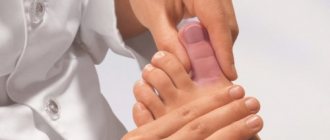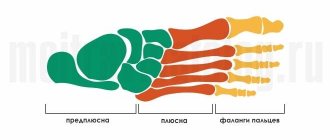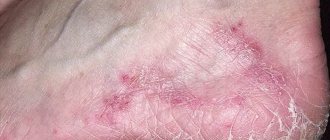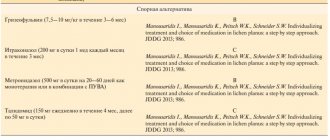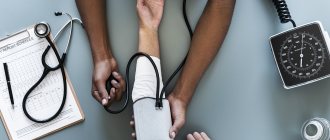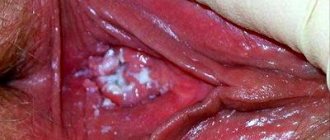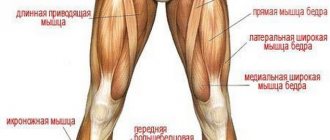Home » Skin diseases » Erysipelas
Symptoms of erysipelas of the lower extremities arise acutely, their severity quickly increases. If timely medical care is not provided, pathological complications develop, which in severe cases can lead to death. Treatment of erysipelas of the leg should be aimed at destroying the causative agent of this infectious disease in the body and reducing the severity of the symptoms of the pathology.
What kind of disease is this?
The disease erysipelas is caused by streptococci, which penetrate the body and disrupt the natural protective barrier.
Main characteristics of the disease:
- Erysipelas most often appears on the legs , since this area of the body most often comes into contact with the ground and other household items that may contain bacteria;
- When contacted with the skin, streptococci penetrate into the layers of the epidermis , destroy cells, resulting in the formation of an inflamed area on the surface of the epidermis;
- The disease can develop rapidly . As a result, bacteria damage the deep layers of tissue, which leads to swelling of the affected area and an increase in the inflammatory process;
- Almost anyone can get erysipelas . However, experts note that males most often suffer at a young age, and females, on the contrary, at an older age.
Patients who are in a prolonged lying position have a high risk of contracting erysipelas. The disease in such cases occurs in the form of inflammation and ulcers on the skin.
Is it contagious to others or not?
Erysipelas is contagious, like any other infectious disease, and is transmitted from person to person. The modes of transmission of infection are contact and airborne droplets. Therefore, those caring for a sick person should beware of too close contact, avoid cuts and injuries, do not put on the sick person’s things, and do not use his towel.
Fortunately, erysipelas is recognized as low-contagious (as experts call diseases with a low degree of danger to others): for a person to get sick, just getting infected is not enough; the negative accompanying factors that we talked about in the previous chapter must come together, and this happens in practice extremely rarely.
Instructions for use of Zosterin-Ultra 30 and 60 can be found at this link.
Read about the causes, symptoms, types and treatment of postherpetic neuralgia in this material.
Indications, instructions for using Calamine lotion for chickenpox and reviews of it can be found here:
Reasons for appearance
Erysipelas on the leg can form for the following most common reasons:
- Damage to the skin that was not promptly treated with an antiseptic;
- Combs;
- Insect bites;
- Burn damage to the epidermis;
- Injuries;
- Crack on the sole of the feet;
- Lack of necessary hygiene;
- Prolonged contact with dusty objects;
- Prolonged hypothermia of the extremities;
- Frequent exposure to direct sunlight;
- Lack of treatment for foot fungus;
- Transmission of infectious diseases.
Erysipelas on the leg can be caused by enduring prolonged stressful situations that negatively affect the immune system.
special instructions
Severe forms of erysipelas are treated only in a hospital. Medical professionals need to monitor the patient’s condition and his reaction to taking medications. Mild forms of erysipelas can be treated at home.
Rules for treating erysipelas at home:
- Take medications prescribed by your doctor regularly;
- Change underwear and bedding daily;
- Take a shower every day, do not wipe the affected areas, but dry them;
- Wash the inflamed area with a decoction of chamomile, calendula, sage, coltsfoot;
- At the healing stage, wash the affected area with aloe or Kalanchoe juice.
Erysipelas is a common problem that can affect anyone. Modern medicine with the help of antibiotics is able to overcome this disease in 7-10 days.
At-risk groups
The disease can manifest itself in absolutely any person.
However, the following categories are at risk:
- Decreased blood circulation;
- Work that requires sitting in one place for a long time;
- Hereditary predisposition;
- Diabetes mellitus;
- Adherence to bad habits;
- Phlebeurysm;
- Carrying out long-term excavation work;
- Failure to comply with sanitary measures.
These categories of people are recommended to follow preventive measures and saturate the body with useful minerals and vitamins.
Manifestation at the initial stage
Erysipelas on the leg manifests itself at the initial stage with the following unpleasant symptoms:
- Burning sensation on the skin;
- Painful sensations;
- Feeling of skin tightness;
- The appearance of a small pink spot that tends to increase in size;
- The appearance of a feeling of heat upon contact with the skin;
- There is visible swelling of the skin.
The disease tends to progress quickly and affect new areas of the skin, manifesting itself with more severe symptoms.
Pathological anatomy
A sharply hyperemic lesion appears on the skin (less often on the mucous membrane of the mouth and nose), which quickly turns into a painful, red, dense, clearly demarcated erysipelas with jagged outlines. Microscopically, with the erythematous form of R., serous inflammation of the dermis, mainly its reticular (mesh) layer and underlying tissue, is detected. Serous exudate contains neutrophilic leukocytes and an admixture of lymphocytes. Severe plethora, hemorrhages, lymphostasis, vein thrombosis, and tissue edema are observed. The walls of the vessels are infiltrated with granular leukocytes (granulocytes). Collagen and elastic fibers swell. Using staining using the Romanovsky-Giemsa and Gram methods, streptococci can be identified, which sometimes accumulate in the tissues and capillaries of the affected area. In the epidermis above this area, desquamation and mild parakeratosis are noted (see).
With a significant amount of transparent yellow serous exudate (see), accumulating under the epidermis, bubbles of different sizes are formed. Sometimes the exudate becomes cloudy due to the abundant accumulation of neutrophilic leukocytes in it, the blisters turn into pustules. The exudate may be hemorrhagic in nature, sometimes mixed with fibrin.
Recurrent R. that occurs repeatedly on the same area of the skin leads to sclerosis of the dermis, subcutaneous tissue, impaired lymph circulation and the subsequent development of elephantiasis (see).
With R., no blisters form in the mucous membranes; the tissue is plethoric, with foci of necrosis, and edematous.
In internal organs there may be dystrophic changes, hyperplasia of the spleen pulp.
Symptoms of erysipelas on the leg
The disease erysipelas on the leg is manifested by the following symptoms:
- Headaches may decrease and occur with varying intensity;
- Muscle pain , especially late in the day;
- Feeling of chills and general weakness;
- A sharp increase in body temperature , without any prerequisites;
- Stomach upset and nausea;
- The appearance of a red spot on the skin may become darker depending on the rate of progression of erysipelas;
- Bruising on the epidermis at the site of bacterial infection;
- Inflammation and swelling.
The person experiences a lack of appetite and sleep disturbance.
Characteristic signs and symptoms
The incubation period lasts from 3 to 5 days. The onset of the disease is most often an acute period, with a sharp rise in temperature. Symptoms indicate general intoxication of the body. This:
- excruciating headache;
- fever and chills;
- vomit;
- muscle aches;
- convulsions;
- severe weakness.
Local symptoms are added to the general symptoms. For erysipelas, the local symptom is redness of an area of skin, for example, on the leg - it not only changes its color, but also swells and begins to become shiny, due to the fact that the skin is very tense.
Another characteristic feature is the formation of a demarcation ridge with uneven edges at the border of healthy and diseased skin. If you press on the red spot with your finger, it will turn pale for a few moments, and then the redness will return. It feels warmer to the touch than intact areas of the skin. In addition to everything, the patient experiences a strong burning sensation.
With this disease, there is also an inflammatory reaction to infection of the lymph nodes under the knees and in the groin area.
If the form of the disease is complicated, the following symptoms appear in the area of inflammation:
- hemorrhages;
- blisters filled with clear liquid;
- blisters with bloody or purulent filling.
Types and forms of the disease
An infectious type of disease, erysipelas on the leg can be divided into various forms and varieties.
The following forms of the disease are distinguished:
- Erythematous form - manifested by an inflammatory process, formed in the form of a red spot on the skin with clear boundaries;
- Erythematous-bullous form - manifests itself on the epidermis with the formation of a red spot, after a few days it begins to peel off and peeling of the skin is observed. At the site of the lesion, blisters with liquid appear after the injury, and a crust appears;
- Erythematous-hemorrhagic form - in addition to the main symptoms of redness of the epidermis, the formation of places with hemorrhage is observed;
- The bullous-hemorrhagic form is the appearance of an inflammatory area on which pimples appear with a cloudy liquid mixed with blood.
The following types of erysipelas on the leg are also distinguished.
Depending on the severity of the current:
- Mild degree - manifests itself with mild symptoms;
- Moderate severity - manifested by symptoms that reduce their intensity;
- Severe severity – the disease develops rapidly and is difficult to treat.
By degree of occurrence:
- Primary – erysipelas on the leg appears for the first time;
- Recurrent – the disease arises and disappears on its own;
- Recurrence – appears after a certain time after treatment.
Only an experienced specialist can correctly determine the form and type of erysipelas, who, based on the type of disease, can prescribe the necessary type of treatment.
Diagnostics
If you suspect erysipelas, you should contact an infectious disease specialist. During the examination, this doctor finds out how the person’s well-being has changed since the first signs of pathology appeared, examines and palpates the affected area.
To confirm the infectious-inflammatory nature of the pathology, the doctor prescribes a general blood test. With erysipelas, this study reveals the following changes:
- An increase in the number of leukocytes more than 10.1*109/l. In case of a generalized process or the development of erysipelas against the background of an immunodeficiency state (for example, with cancer, treatment with glucocorticoids, AIDS), the level of white blood cells will be below 4*109/l.
- The erythrocyte sedimentation rate (ESR) exceeds 20 mm/hour, sometimes reaching 30–40 mm/hour.
- In the hemorrhagic form of the disease, a decrease in the level of hemoglobin (less than 120 g/l), red blood cells (less than 4.4*1012/l in men and less than 3.8*4*1012/l) is possible.
In case of an atypical course of pathology, a bacteriological examination is carried out to clarify the diagnosis. To do this, apply a glass slide to the wound or ulceration in the lesion, then examine it using a microscope.
Treatment methods and their features
To achieve results in treatment, it is recommended to use the following methods:
- Medicinal influence on the problem;
- The use of external medications to eliminate unpleasant symptoms;
- Physiotherapy treatment;
- Compliance with a special type of nutrition;
- Surgical intervention.
Features of the treatment of erysipelas on the leg:
- External therapy products are used only at the site of inflammation;
- Before starting to use external preparations, it is recommended to treat the affected area and hands with an antibacterial substance;
- Saturate the body with useful vitamins and minerals to increase the body’s protective functions;
- In difficult cases, which are accompanied by high temperature , it is recommended to use antipyretic substances;
- Erysipelas on the leg requires careful hygiene . To prevent further development of the disease.
If a severe course of the disease is observed or the symptoms of erysipelas quickly spread to healthy areas of the skin, the patient must be hospitalized; in other cases, treatment is carried out on an outpatient basis.
What should not be done when treating erysipelas?
Treatment of erysipelas on the leg requires compliance with certain rules.
The following actions are strictly prohibited:
- Be in direct sunlight;
- Self-administer various medications;
- It is prohibited to use products for external use that tend to improve blood circulation;
- Relieve the feeling of heat with compresses;
- Treat the affected area with water.
Ignoring this kind of prohibition can lead to the rapid spread of infection to healthy areas of the body.
Etiology
The causative agent of P is Streptococcus pyogenes, a hemolytic group A streptococcus (see Streptococci). It was first isolated in erysipelas by V.V. Lukomsky (1874-1876) and T. Billroth (1874). Fehleisen (F. Fehleisen, 1882) discovered streptococcus in areas of erysipelas, in lymph vessels, subcutaneous tissue and superficial layers of the skin. These data were confirmed by R. Koch. According to the observations of I.I. Mechnikov, the largest accumulations of streptococcus are often located in the peripheral zone of the affected area. But if earlier streptococcus was constantly found in areas of erysipelas of the skin, now this has become a rarity, which is due, according to E. A. Galperin (1960), to the intensive use of antibiotics.
Etiol. the role of streptococcus in the occurrence of R. was experimentally confirmed by Feleisen, who managed to cause the disease in rabbits. infecting them with streptococcal cultures isolated from patients with R. It has also been noted that R. is often preceded by acute streptococcal infections such as, for example, tonsillitis (see). Recurrent R. of the face and head is usually associated with the presence of foci of chronic streptococcal infection - sinusitis, rhinitis. Streptococci of the same type were found in patients with R. in the mucus of the throat and on the affected area of the skin.
In patients with R., usually from the first days of the disease there is a high level of antitoxic immunity and specific sensitization - delayed-type hypersensitivity (see Allergy) to streptococcal antigens. According to V.L. Cherkasov (1963) and M.N. Smirnova (1971), at the onset of the disease, increased titers of antibodies to extracellular products and enzymes of streptococcus are also observed. At the same time, the use of bicillin to prevent relapses of R. gives a reliable effect, as with other streptococcal infections.
Etiol. the role of group A streptococci in the development of R. is confirmed by the constantly and long-term observed increased titers of antibodies to O-streptolysin and streptococcal enzymes (hyaluronidase, streptokinase), as well as their increase during primary and repeated R.; frequent detection of streptococcal antigens in the urine and blood of patients with R. (and treatment with penicillin leads to their disappearance); increased titers of antibodies to group A streptococcal polysaccharide (A-polysaccharide) in patients with primary and repeated R. starting from the 2nd week. disease, and in patients with recurrent R. - from the first days and maintaining antibodies at the same level for a long time; the direction of these antibodies to the A-polysaccharide determinant, specific for group A streptococci.
At the same time, streptococci belonging to the same types of group A can cause not only R., but also other pathol. processes. With streptococcal infections, the development of a particular disease apparently depends not on the characteristics of the pathogen, but on the nature of the immune response to various antigens, the gates of infection and other conditions that determine the body's response to streptococcus. At the same time, the possibility of the presence of special group A streptococci - pathogens of P.
Drug treatment
The use of medications can reduce the further spread of the disease and eliminate unpleasant symptoms.
However, the use of medications requires special monitoring by the doctor of the treating patient. The prescription of medications depends on the characteristics of the body and the form of the disease.
Antibiotics
The use of antibiotics for erysipelas on the leg helps eliminate further development of the infection and activate the processes of restoration of epidermal cells.
Antibiotic therapy is most often used for moderate and complex levels of disease progression.
Staphylococci do not respond well to antibiotics, so to eliminate the infection it is necessary to use a certain type of medication.
The most effective antibiotics for treating erysipelas:
- Cephalexin is a drug used to eliminate various microbes, including staphylococci. The result of use is achieved 1 day after application. The drug is taken after meals with plenty of water. The cost of the drug is 90 rubles . Dosage: for adults - 1 tablet twice a day, course of treatment up to 14 days;
- for children over 3 years old - it is recommended to use the liquid form, 5 ml twice a day, for up to 7 days;
- for children over 10 years old - 10 ml twice a day for 7 days;
- for adults – one tablet is prescribed once a day, the course of treatment is prescribed individually, but not more than 14 days;
- for adults - the drug is prescribed at 700 mg per day, depending on the complexity of the disease, the duration is determined individually for each patient;
Cephalexin
Cefixime
Cefuroxime
Prescribing antibiotics can disrupt the natural processes of digestion, so with this type of treatment it is recommended to use special preparations containing beneficial bacteria.
Immunomodulators
They are prescribed to enhance the body’s natural processes in the fight against infectious lesions and prevent further progression of the disease.
Most often used:
- Arbidol is a drug to eliminate infections caused by various microorganisms. Used during pregnancy. The drug is prescribed one tablet per day for adults. Course up to 21 days. For children over 2 years of age, the dosage is determined individually. Average cost 400 rubles ;
- Thymogen - prescribed to improve immunity and fight infectious diseases. The average cost is 350 rubles . Dosage: for adults - 100 ml per day, course of treatment for no more than 7 days;
- children from 2 to 5 years old - no more than 20 ml per day, duration of treatment no more than 3 days;
- children from 5 to 14 years old - no more than 40 ml per day, depending on the child’s weight. The course of treatment is up to 5 days.
Arbidol
Thymogen
The selection of drugs to enhance immunity is made individually for each case. The choice of drug is influenced by the number of symptoms and the severity of the disease.
Vitamin complexes
The use of vitamin preparations can strengthen blood vessels and improve immunity.
It is recommended to saturate the body with vitamins A, B, C. In complex cases of the disease, specialists may prescribe the use of ascorbic and nicotinic acids.
Nonsteroidal drugs
Treatment of erysipelas on the leg is carried out with non-steroidal drugs in case of an increase in unpleasant symptoms, such as pain and inflammation.
The most prescribed drugs:
- Ketoprofen is prescribed to eliminate inflammation and pain. Used when necessary, but no more than 3 times a day. Not used for children and during pregnancy. Average cost 160 rubles ;
- Piroxicam - eliminates swelling of the skin, is used in the treatment of erysipelas on the leg as a means of blocking the further development of the inflammatory process. One tablet is prescribed once a day. In case of severe pain, the dosage can be increased to 4 tablets per day. Average cost 220 rubles ;
- Ibuprofen is the most common remedy against inflammation and pain symptoms. The average cost is 90 rubles . Dosage: for adults - 1 tablet every 6 hours, duration no more than 10 days;
- for children from 6 months - a liquid form is used depending on the child’s weight. The course of treatment is prescribed individually, the drug is used when unpleasant symptoms increase.
Ketoprofen
Piroxicam
Ibuprofen
These drugs are recommended to be used as additional therapy in cases of exacerbation of symptoms.
Nonsteroidal drugs do not eliminate the disease; they block the further spread of the inflammatory process and eliminate unpleasant symptoms.
Ointments and powders
The use of products for external application during the treatment of erysipelas on the leg allows you to speed up the healing process and start the process of restoration of skin cells.
The most commonly used:
- Naftalan cream - used to restore damaged cells and reduce swelling. It is recommended to apply the cream in a thick layer to the affected area for 30-40 minutes, twice a day, after which the substance is removed. The course of treatment is at least 15 days. Average cost 80 rubles ;
- Erythromycin ointment - the substance contains an antibiotic that eliminates microbes and enhances blood circulation in damaged cells. This speeds up the skin restoration process. Apply a thin layer twice a day for no more than 10 days. Average cost 60 rubles ;
- Sinaflan ointment is prescribed to eliminate harmful bacteria and reduce unpleasant symptoms on the surface of the skin. When treating erysipelas on the leg, the ointment is used twice a day as prescribed by the attending physician. The duration of treatment is no more than 7 days. After applying the powder to the site of inflammation, it is recommended to apply a bandage for several hours. The average cost is 80 rubles .
Naftalan cream
Erythromycin ointment
Sinaflan ointment
Products for the external treatment of erysipelas on the leg are recommended to be applied with extreme caution using cotton swabs to prevent skin damage and further spread of infection.
Description
Erysipelas is an infectious-allergic disease of the skin and mucous membranes, caused by beta-hemolytic streptococcus.
Has a code according to ICD-10 A.46.0. It manifests itself as intense redness of the affected area, serous or serous-hemorrhagic inflammation, enlargement of regional lymph nodes, fever, and symptoms of intoxication. Most often it affects the face and legs. It can acquire a recurrent course, complicated by the formation of necrosis, the development of thrombophlebitis, abscess, and phlegmon. Erysipelas ranks 4th in terms of prevalence in the structure of infectious diseases. It is detected sporadically, there is no transmission to others. Children get sick extremely rarely. From the age of 20, the incidence gradually increases, and at the age of 20-30 men are more often affected, then a predominance of women is observed.
Peak occurrence occurs between 41 and 65 years of age. 70% of the total number of patients are representatives of the fairer sex. The most vulnerable category is older, overweight patients with a complicated allergic history. In 30% of cases there is a relapsing course.
Reasons for development
The pathology is provoked by any strains of group A beta-hemolytic streptococcus. Bacteria of this group are widespread and cause many infections: tonsillitis, pharyngitis, scarlet fever, pneumonia, glomerulonephritis, wound suppuration, and some skin diseases. Most often, the causative agent is Streptococcus pyogenes, which can be found on the skin and nasopharyngeal mucosa of healthy people.
The predominant route of transmission is contact. The pathogenic agent penetrates the skin through cracks, abrasions, abrasions, scratches, and insect bites. The infection is transmitted through dirty hands, clothes and shoes, unsterile dressings and medical instruments. Less commonly, microbes initially enter the nasopharynx and are then transferred to the skin by the patient’s hands. Hematogenous and lymphogenous infection is possible.
Susceptibility to infection varies significantly. In some people, the disease does not develop even with a large area of wound surfaces and heavy contamination, while others become ill with the slightest damage to the skin. The following predisposing factors are identified:
- Physical work . More than a third of patients are people with physical labor: cleaners, loaders, mechanics, carpenters, drivers, electricians. This is due to contamination and frequent microtrauma of the skin during professional duties.
- Elderly age . Pensioners get sick a little more often than representatives of the previous group. Experts explain this by frequent immune disorders, neglect of hygiene rules, general deterioration of the body, and the presence of chronic diseases.
- Other infections . Patients with chronic tonsillitis suffer from erysipelas 6 times more often than healthy people. The likelihood of pathology increases in the presence of caries, diseases of the ENT organs and the oral cavity.
- Local pathological processes . The occurrence of erysipelas of the lower extremities is promoted by lymphovenous insufficiency, lymphedema, trophic disorders (including diabetes mellitus), edema of various origins, and fungal infections of the feet.
- Excess weight . The increased likelihood of disease is associated with favorable conditions for the development of infection that occur when the layer of subcutaneous fatty tissue is significantly thick.
- Tendency to allergies . Many patients have a history of allergic reactions. High allergization is combined with a decrease in the body's immune forces.
- Hereditary predisposition . In 10% of patients, among the closest relatives, people are identified who also suffered from erysipelas.
Early relapses of erysipelas are often caused by activation of the patient’s own microflora. Late relapse (more than 6-7 months after the disappearance of symptoms) and repeated cases of the disease are usually associated with repeated endogenous infection. There are pronounced seasonal fluctuations, with the maximum incidence occurring in the summer-autumn period, from June to October.
Development mechanism
After penetrating the skin, streptococcus enters the lymphatic capillaries and multiplies in them. This leads to abundant production of endo- and exotoxins, which enter the circulatory system and spread throughout the body, causing fever, chills and intoxication syndrome.
The local inflammatory process is infectious and allergic in nature. Immune complexes are formed in the skin of the affected area, causing complex damage to small blood and lymphatic vessels. Clots and microthrombi form in the lumen of the capillaries. The walls of blood vessels are destroyed. Multiple hemorrhages occur. Disorders of local circulation lead to the formation of blisters with serous or serous-hemorrhagic contents.
If the hemorrhages are deep, or another infection is attached, the process may become more aggravated with the formation of areas of necrosis, the development of phlegmons and abscesses. As a result, sclerosis of the lymphatic vessels and replacement of the skin with connective tissue is observed. Multiple relapses contribute to the accumulation of pathological changes and the development of progressive disorders of lymph outflow.
Classification
Russian experts usually use Cherkasov’s classification, which distinguishes the following types of erysipelas:
- According to local symptoms : erythematous, erythematous-bullous, erythematous-hemorrhagic, bullous-hemorrhagic.
- According to the severity of intoxication syndrome : mild, moderate and severe.
- According to the nature of the course : primary, repeated (forms after 24 months or more in another place), recurrent (develops within up to 24 months or manifests itself in the same place after more than 2 years).
- According to the volume of the lesion : localized, migrating, metastatic (with the formation of distant foci).
Complications of erysipelas can be general and local. In the long-term period, the following consequences are distinguished: lymphedema, secondary elephantiasis.
Physiotherapy
One of the effective methods of treating erysipelas on the leg is the use of physiotherapy procedures.
Which should include:
- The use of ultraviolet irradiation is prescribed to eliminate microbes in the layers of the epidermis. To carry out the procedure, a special device is used that extracts low-intensity rays. Use is prohibited in the presence of ulcers and purulent formation at the site of inflammation. To achieve the effect, it is necessary to carry out at least 5-7 procedures;
- Electrophoresis is the application of small electrical discharges to the source of inflammation. The use of this type of procedure irritates the nerve endings and triggers the natural processes of restoration of the epidermis. During the procedure, special electrodes are applied to the place where the erysipelas is located. The duration of the procedure is no more than 15 minutes; it is recommended to carry out at least 10 procedures;
- Cryotherapy – used for complex types of infection. The essence of the procedure is to use a special substance that freezes the top layer of the damaged area. As a result, microbes die at low temperatures. It is prohibited to carry out such treatment during pregnancy and childhood.
Ultraviolet irradiation
Electrophoresis
Cryotherapy
Physiotherapy methods are recommended to be carried out in conjunction with drug treatment to increase the result of treatment.
How to treat
The diagnosis of the disease is made against the background of the medical history, examination data, and examination results. A blood test and bacteriological examination are mandatory.
In some cases, consultation with an endocrinologist, surgeon, or otolaryngologist will be required.
In advanced cases, treatment of the disease is carried out in a hospital, and therapy is completed at home.
A complex effect is needed that will help eliminate the symptoms of erysipelas and improve the patient’s condition.
This includes:
- Taking antibiotics. Drugs are prescribed to combat the pathogen. This could be Erythromycin, Doxycycline.
Along with antibiotics, multivitamin preparations, biostimulants, proteolytic enzymes, antibacterial and antihistamine medications are prescribed. - Treatment of the affected area. Aerosol and powders are used daily.
Applications are made using Dimexide and bandages are applied with Furacilin. - Physiotherapy. They are aimed at stopping inflammation. For elephantiasis and lymphostasis, physiotherapy is prescribed to activate the metabolism of connective tissue cells.
Electrophoresis, UHF therapy, magnetic therapy, paraffin, hydrogen sulfide, sodium chloride baths are usually used.
Careful hygiene and strengthening the immune system play an important role.
During the therapeutic course and after it, experts recommend:
- eat more healthy fats and protein;
- increase the amount of honey in the diet;
- maintain a daily routine;
- avoid stress and overwork;
- exclude alcohol, tobacco and caffeine;
- restore the gastric microflora with a balanced diet;
- change bedding and underwear daily;
- wear clothes made from natural fabrics that do not touch the wound;
- After a shower, do not use paper towels until the inflammation has healed.
In combination with antibiotic therapy, traditional methods of treatment can be used. As non-traditional remedies, ointments from burdock, chamomile, honey, decoctions of calendula, nettle, sloe, and blackberry are used.
Surgical intervention
The use of surgical intervention in the treatment of erysipelas on the leg is recommended for the following cases:
- The infection does not respond to other types of treatment;
- The infection quickly spreads to healthy areas of the body;
- The infection affects the deep layers of soft tissue;
- On the surface where erysipelas is located, there is an accumulation of purulent masses.
Before the procedure, the necessary tests are carried out and local anesthesia is administered. The surgeon uses a scalpel to remove damaged tissue.
Carrying out such a procedure requires a long recovery period after surgery and the use of a special type of treatment of the damaged area.
Diagnosis
The diagnosis is usually made on the basis of medical history and the results of an objective examination.
Specific lab. diagnostic methods have not been developed. To detect streptococcal infection, the determination of antibodies to O-streptolysin and hyaluronidase can be used.
Differential diagnosis is carried out with various erythemas and dermatitis. Spots with erythema infectiosum (see Erythema infectiosum) are painless and, as a rule, appear on the extensor surfaces of the extremities. The increase in temperature is insignificant or completely absent.
The affected areas with R. are shiny, painful, dense to the touch, the redness is not interrupted by areas of healthy skin and does not disappear with pressure. the edges of the hyperemic area of skin are sharply demarcated from healthy skin and raised in the form of a roller, which does not happen with erythema.
Acute eczema (see), accompanied by redness of the face, resembles R., but with eczema, the process covers the entire face from the very beginning, and the redness imperceptibly, without sharp boundaries, spreads to healthy skin.
It is also necessary to differentiate erysipelas with abscess and phlegmon, phlebitis (see), thrombophlebitis (see-, herpes zoster (see Herpes), periarteritis nodosa (see Periarteritis nodosa), erysipeloid (see), cutaneous anthrax (see). cm.).
Treatment with folk remedies
The use of home therapy methods is used for mild stages of the disease. There are external methods for eliminating erysipelas and substances for eliminating infection in the body.
External treatment
To eliminate unpleasant symptoms and swelling of the skin, the following methods are used:
- Plantain – has an antibacterial effect and reduces inflammation. It is necessary to use three leaves of a freshly harvested plant. Grind with a blender and apply the resulting porridge to the erysipelas on your leg. Secure with a bandage and leave overnight. Duration of treatment is up to 15 days. Contraindicated in case of individual sensitivity to the plant;
- Raisin compresses – to prepare such a compress, you need to use a handful of light raisins and add water for a few minutes. Drain the liquid and crush the raisins into a paste. Apply the resulting mixture to a piece of gauze and apply to the erysipelas on the leg three times a day. The course of treatment until the unpleasant symptoms disappear completely;
- Chalk powder - the use of this type of powder reduces favorable conditions for further proliferation of microbes and blocks their activity for some time. It is recommended to crush one piece of chalk and sprinkle it on the damaged area twice a day for up to 15 days. It is forbidden to use in case of purulent formations and the presence of ulcers.
The use of such methods can reduce the progression of the disease in the early stages, however, for later treatment, the use of drug treatment is recommended.
Products for internal use
The use of internal treatment methods using traditional medicine makes it possible to strengthen the resistance of the immune system and eliminate damage to the deeper layers of soft tissue.
Very often used:
- Burnet infusion - you need to pour a glass of crushed herbs with three glasses of boiling water and leave for 20 minutes. Use two tablespoons twice a day. Duration up to 15 days;
- Medicinal mixture - combine coltsfoot grass, chamomile flowers and liquid honey in equal quantities. Stir and chew the composition one teaspoon twice a day. The course of treatment is up to 10 days;
- Tincture of celery, golden mustache and honey - mix chopped celery root, golden mustache and honey in equal quantities. Infuse for 14 days in a dark place, take one teaspoon three times a day. The course of treatment until the inflammatory process is eliminated.
Before using traditional medicine methods, it is recommended to first consult a doctor.
Mental disorders during erysipelas
Mental disorders in R. are rare and belong to infectious psychoses (see). Their occurrence and nature depend on the characteristics of the course of R., the severity of local and general somatic manifestations, as well as the localization of the process. More often, mental disorders develop with erysipelas of the face and scalp. The most common mental disorders include hypnagogic delirium (see Delirious syndrome). With a more severe, protracted course of erysipelas, the development of amentia syndrome is possible (see), which may be preceded by a short-term hypomanic state with euphoria (see Manic syndromes). Psychoses are transient in nature. As the somatic condition improves, even before the onset of complete recovery, they may give way to phenomena of emotional-hyperesthetic weakness (see Symptomatic psychoses). Hypochondriacal and depressive disorders are sometimes associated with these symptoms.
Mental disorders in R. must be differentiated from other mental illnesses (schizophrenia, manic-depressive psychosis), the manifestation or exacerbation of which can be provoked by infection.
Treatment of psychosis in R., in addition to measures aimed at combating the underlying disease, should include the use of sedatives, antipsychotics, nootropic drugs (nootropil, aminonalone, encephabol), as well as general restorative therapy.
Recommendations for treatment
To achieve a more visible result in the treatment of erysipelas on the leg, experts advise following the following useful tips:
- Conduct an individual sensitivity test before using any medicinal product for external use. To do this, apply the drug to the wrist or hand, wait 20 minutes, if no unpleasant consequences arise, you can safely use the drug;
- The patient must remain supine during the entire treatment period;
- You should immediately contact a medical facility when the first symptoms of the disease appear;
- Avoid contact of the place where the erysipelas is located with healthy areas of the skin;
- Do not use medications yourself to eliminate unpleasant symptoms to avoid unpleasant consequences.
During the period of therapy, it is necessary to carefully monitor the absence of damage at the sites where erysipelas appears on the leg; if blisters and crusts appear, it is forbidden to independently violate the integrity of the formation’s membrane.
Expert advice
During treatment, some things are strictly prohibited. Therefore, experts advise observing these prohibitions so as not to harm the sore leg even more:
- When applying lotions or powders to the affected area, do not tie bandages or cloth tightly. The bandage should be done gently and very loosely.
- Every time the bandage needs to be changed, it is necessary to treat the damaged skin with an antiseptic. Disinfection is of great importance in infectious diseases.
- It is advisable to provide the patient with complete rest. Even if he is being treated as an outpatient, his loved ones should make sure that no one disturbs him. Moreover, it is better to limit communication with the carrier of the infection.
- Do not allow the patient to come into contact with synthetic fabrics. Bedding and clothing must be of natural quality.
- Change bed linen daily. Wash at the highest temperatures.
- If treatment is carried out on an outpatient basis, be sure to follow the dosage and complete the full course of treatment with medications. Otherwise, a relapse is possible with more dangerous complications.
- To make dressing easier, it is better to apply ointments on napkins and apply them to the sore spot.
- Be in the shower more often. Wash the affected area with lukewarm water and soap. Do not rub the skin.
- Kalanchoe plant juice or rosehip oil will help with peeling skin.
Special diet
To eliminate the disease erysipelas on the leg, it is recommended to follow a special type of diet.
The essence of such nutrition is to saturate the body with the necessary beneficial vitamins and minerals, which reduce the progression of the disease and increase the natural protective processes of the immune system.
It is recommended to include the following types of foods in your diet:
- Apples;
- Pears;
- Peaches;
- Apricots;
- Carrot;
- Oranges;
- Milk;
- Honey;
- Dried fruits;
- Green tea;
- Raspberries;
- Low-fat fish.
The following types of products are prohibited:
- Caffeine;
- Spices;
- Smoked meats;
- Fatty foods and cooked by frying;
- Spicy and salty foods;
- Sweets;
- Canned food.
It is recommended to drink plenty of fluids daily.
In the presence of acute phases of the disease, it is recommended to eliminate all foods containing a large amount of calories.
This is due to the fact that the stomach will not be able to digest foods in a timely manner during illness, which will lead to an increased level of toxins.
Nutrition
Diet therapy plays an important role . It will speed up your recovery.
The following products are indicated for the patient:
- carrot;
- apples;
- pumpkin;
- currant;
- mineral water;
- fish;
- nuts;
- cheese;
- seafood.
It is necessary to exclude coffee and chocolate, marinades, smoked foods, hot spices and seasonings.
Features of the disease in children and during pregnancy
The manifestation of the disease during pregnancy may have the following features:
- Symptoms of the disease negatively affect a woman’s health and can develop rapidly;
- Treatment is prescribed depending on the complexity of the disease . In mild stages, the use of antibiotics is not recommended;
- Antibiotics are used in reduced dosages and only approved drugs;
- The woman should be under constant supervision of the attending physician and gynecologist.
Experts recommend closely monitoring your health and promptly contacting a medical facility if any changes occur.
Erysipelas on the leg in childhood has the following features:
- The occurrence of infection in childhood can quickly be transmitted to healthy areas of the body and occur in a more severe form;
- When a diagnosis of erysipelas is made, it is recommended that the child be urgently hospitalized for further treatment;
- For children, it is recommended to use more gentle treatment methods , as well as strictly follow the instructions;
- In children, erysipelas most often manifests itself as high fever and itching in the affected area.
Children are very susceptible to various types of infections, so to prevent the disease it is necessary to monitor the child’s hygiene.
Epidemiology
R. is observed in the form of sporadic cases, distributed everywhere. According to M. G. Raskovalov (1970, 1973), the incidence of R. is 12-20 per 10 thousand population.
The source of the infectious agent is patients with various streptococcal infections, and in particular R., as well as carriers of streptococci. Pathogens are transmitted mainly through hands, underwear, clothing, etc. contaminated with streptococcus; airborne transmission cannot be excluded. The disease is less contagious. The general and local predisposition of the body to this disease is of great importance. Some researchers tend to classify R. (in particular, recurrent) as an autoinfection, when infection occurs endogenously. It has been noted that more often R. occurs in people suffering from chronic streptococcal infections, and infection occurs through lymphogenous-hematogenous dissemination of streptococcus and, less often, its direct penetration into the skin and mucous membranes through microtraumas, cracks, abrasions, etc.
Possible complications
Lack of timely treatment can lead to the following complications:
- The occurrence of abscesses;
- Pneumonia;
- Ulcers;
- Erosion;
- Necrosis;
- Thrombophlebitis, which occurs as a result of damage by erysipelas to the area where the veins are located;
- Lack of necessary nutrients reaching the muscle tissue layers can lead to cell depletion.
With purulent formations, additional types of infection can occur, which can lead to removal of the limb.
Skin after erysipelas
On average, treatment for erysipelas takes 2-3 weeks. As the local inflammatory response decreases and the amount of streptococcus decreases, the skin begins to renew itself. The redness decreases and a kind of film appears in place of the damaged area - this is the “old” skin being separated. As soon as it is completely rejected, it should be removed independently. There should be unchanged epithelium underneath.
Over the next week, peeling of the skin may persist, which is a normal reaction of the body.
In some patients, erysipelas can take a recurrent course, that is, appear again in the same place after a certain time (several years or months). In this case, the skin will be susceptible to trophic disorders, chronic swelling of the limb or replacement of the epithelium with connective tissue (fibrosis) may form.
Prevention
To prevent the occurrence of erysipelas on the leg, it is recommended to follow the following rules:
- Promptly clean skin lesions and use antibacterial drugs;
- Maintain foot hygiene , eliminate corns and calluses;
- Treat all infectious diseases and avoid prolonged hypothermia;
- Reduce time spent in direct sunlight and avoid overheating your feet;
Following simple rules of prevention will reduce the likelihood of infectious diseases.
Is erysipelas contagious?
Erysipelas of the epidermis is a contagious disease. Streptococcus infection is the main cause of the disease. Dust, dirt, and sewage contain spherical bacteria, but the main carrier of the infection is still an infected person. Microbes seem to be passed along a chain from one to another. Communication with a patient with erysipelas can lead to disastrous consequences.
When caring for it, treating affected areas, carrying out medical procedures, you must use rubber gloves; reusing them is not recommended. Hands should be washed with soap and, if possible, wiped with a cotton swab moistened with medical alcohol. Strict adherence to the rules of behavior with an infected person will avoid trouble.
